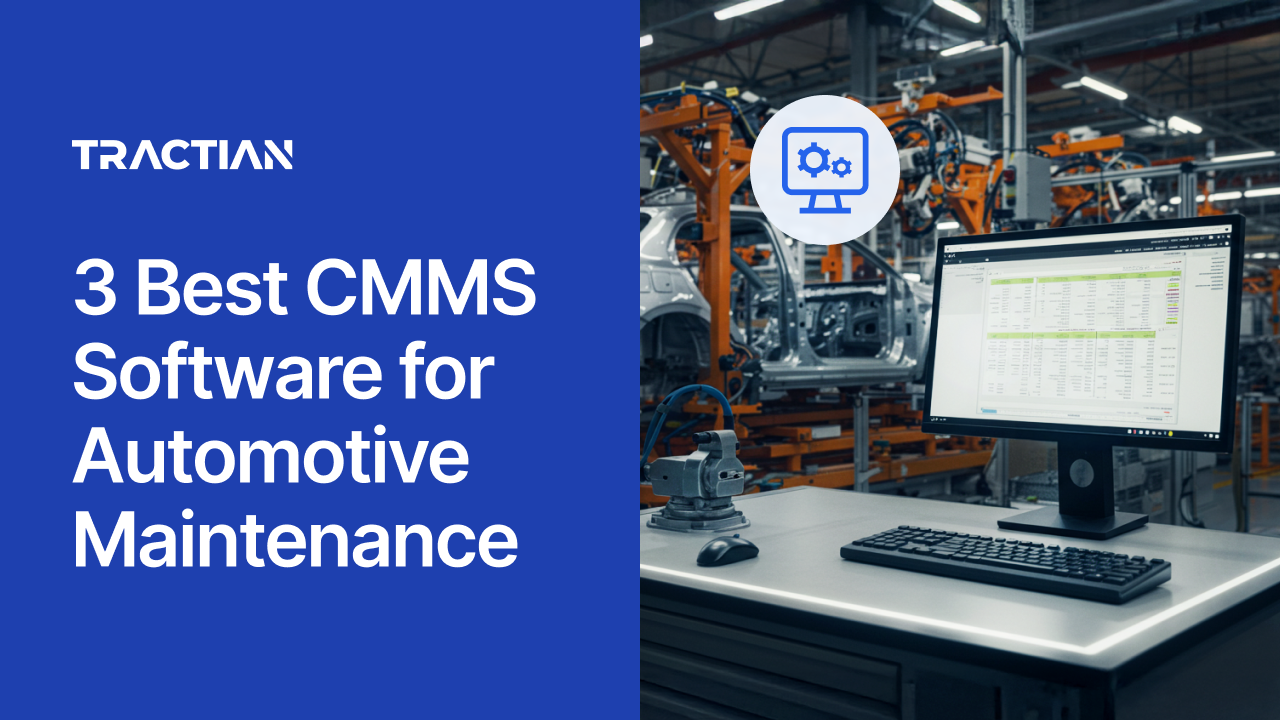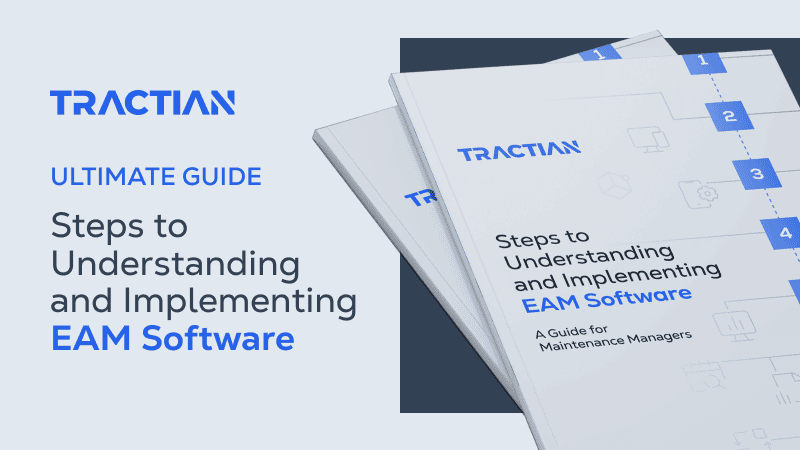In the automotive industry, one missed maintenance task can shut down an entire production line. And when production stops, it’s not just a scheduling problem, you're also going to be affected by missed delivery windows, strained supplier contracts, delayed launches, and potentially millions of dollars in losses.
This is a sector where the margin for error is razor thin, where uptime is non-negotiable, and where even the most routine work orders need to be executed with surgical precision.
That’s why more automotive manufacturers are moving beyond outdated spreadsheets and legacy EAMs, turning instead to CMMS software built for automotive industry. However, not every CMMS is up to the task.
Too many of these tools promise visibility and control, but fail to deliver what automotive teams actually need on the floor: real-time coordination, multi-shift scheduling, standardized procedures, and asset traceability across high-volume, high-speed operations.
This guide breaks down the top 3 CMMS platforms that do more than track tasks: they solve problems. From backlog reduction to tool availability, from SOP enforcement to compliance documentation, these are the solutions that keep production moving and downtime under control.
What Makes Automotive Maintenance Different
In the automotive world, equipment doesn’t just stop working, it causes a lot of other problems too, like interrupting takt time, stalling just-in-time deliveries, and setting off a chain reaction that puts your entire production plan at risk. That’s the difference.
Maintenance here isn't only about general upkeep, but also about protecting throughput, controlling variability, and keeping the line balanced at every stage, from body and paint to final assembly.
It doesn't help the fact that automotive plants operate under relentless pressure to maintain output and meet precision-driven schedules. This means your maintenance team can't just fix problems, but they need to be embedded in the rhythm of the plant, ensuring that automation cells, conveyors, welders, stamping presses, and hundreds of support assets run in sync.
The smallest delay in maintenance execution can create a bottleneck downstream, and what starts as a missed PM can end up as a missed shipment.
That level of complexity demands more from a CMMS. You need a system that’s functional and operationally aware, capable of understanding priority assets, enforcing standards, and giving real-time feedback to planners and technicians. Your maintenance team also needs immediate visibility, accurate diagnostics, and SOPs that your team actually follows.
So what should automotive teams be looking for in a CMMS built to meet those demands?
What to Look for in a CMMS for Automotive Plants
Automotive plants are tightly orchestrated systems where every task, machine, and technician operates against the clock. In an environment like this, a CMMS software can’t act as a passive recordkeeper. It needs to be a dynamic execution layer that enforces procedures, supports the team on the floor, and provides immediate visibility into what’s working and what’s falling behind.
But not every CMMS is built to handle that.
Before we break down your must-haves, it’s worth drawing a line: the platforms we’re evaluating here are not facility-focused tools or generic task managers. Every system that made the shortlist meets four non-negotiables:
- Supports multi-site orchestration with consistent SOPs and performance tracking
- Enables real-time execution at the line level, not just post-shift reporting
- Integrates with MES, SCADA, or ERP systems-no manual reconciliation required
- Handles high-throughput, tool-intensive, and compliance-driven operations with ease
If a platform can’t do those things, it’s not on this list because it’s not built for how your operation actually runs
In addition to those non-negotiables, here’s what you should be looking for in a CMMS for your operation:
- Work Order Management Built for the Floor: Whether it’s torque wrenches, calibrators, or machine-specific parts, your CMMS needs to show what’s available, and where, before the task begins. Every work order should automatically link to required materials and tooling, minimizing delays and guesswork.
- SOP-Embedded Tasks: From torque calibration and tool changeovers to mold inspections and conveyor alignment, every step should follow a structured checklist embedded within the work order. Especially in regulated or high-variability environments, structured SOPs drive consistency, reduce error, and ensure tribal knowledge becomes standardized procedure.
- Inventory and Tool Control Without the Paper Trail: A disconnected parts system leads to idle time. The best CMMS platforms pull from live inventory data, linking parts and tools directly to work orders, so techs know exactly what’s needed and where to find it, before they walk out.
- Backlog and KPI Visibility in Real Time: Monthly reports are too late in a world that runs on cycle times and OEE. You need live views of technician workloads, overdue tasks, and downtime risks across lines or facilities. Look for systems that surface MTBF, MTTR, and task status instantly, not buried in exports.
- Dynamic Scheduling That Responds to Shifting Priorities: High-throughput production is never static. Your CMMS should support scheduling based on downtime windows, technician skills, and asset risk, not just calendar dates. When an unexpected fault pulls a tech off one task, the rest of the plan should rebalance in real time.
- Predictive Maintenance That Flags Risk Early: Alerts are only valuable if they lead to action. Look for platforms that don’t just flag anomalies, but connect them to task generation, inventory needs, and resource planning so your team can act early instead of just reacting fast.
- Audit-Ready Compliance Support: Regulatory pressure in automotive is real, and audits don’t come with a warning. Your system should automatically log every action: timestamped, linked to a technician, and export-ready. If you need to “prepare” for an audit, your system’s already too late.
- Unified Oversight for Multi-Site Operations: Whether you’re managing five lines or five plants, your CMMS should give you one operational view, standardizing SOPs, comparing execution rates, and tracking technician output across the board. You shouldn’t need multiple systems or custom tools to see how each site is performing.

The 3 Best CMMS Platforms for Automotive Maintenance in 2025
There’s no shortage of CMMS platforms claiming they can support your maintenance operation. Some were built for offices, others repurposed from facility management. But when it comes to automotive plants, where downtime bleeds throughput and missing a task means disrupting production flow, very few actually deliver where it counts.
This guide does not simply list the most popular platforms. It highlights the ones that truly perform under pressure. These are CMMS solutions that demand precision, stay grounded in real conditions on the factory floor, and grow alongside your operations.
1. Tractian
Best for: Automotive teams needing real-time coordination, technician accountability, and complete asset traceability.
Tractian isn’t a legacy system adapted for the floor, it was actually designed to live there. Every feature in the platform is engineered around technician usability, execution consistency, and live visibility for planners and managers. No overbuilt workflows, no clunky interfaces. Just a single environment where work orders, SOPs, KPIs, and asset data are always in sync and always accessible.
The platform captures technical routines, tribal knowledge, and diagnostic patterns, then turns them into structured SOPs that technicians can follow without guesswork. These SOPs are embedded directly into work orders, whether it's a torque check on a critical fastening station or an inspection on a high-cycle welding robot.
Also, no other CMMS on this list combines SOP enforcement, offline execution, and built-in compliance as a single, technician-first workflow.
What stands out:
- Built mobile-first, with offline access and shift-to-shift continuity in mind
- AI-generated SOPs embedded into tasks, enforcing standard work and regulatory compliance
- Live KPIs per line, per shift, fueling production readiness and Gemba insights
- Makes tribal knowledge teachable, accelerating ramp-up and retraining
- Global standards, local control: scaled for real automotive networks
What customers are saying:
- “The ease of tracking equipment without having to constantly observe. Tractian does the work for you.”, says Jordan D., Maintenance Supervisor in an Enterprise.
- "I like that I can track all of our assets from one location. If a motor is having issues in one part of the plant , and then another on the other side of the plant I am able to basically troubleshoot both motors in one location.”, says Nicholas D., Maintenance Lead Supervisor.
2. IBM Maximo Application Suite
Best for: IT-led organizations prioritizing integration and control, less so for maintenance teams that need speed, clarity, and floor-level adoption.
Maximo is often positioned as a one-size-fits-all EAM, but in practice, it’s heavy, complex, and built with IT system architecture in mind, not technician workflows. For automotive operations with tight production windows, shifting labor, and execution pressure, Maximo requires a level of customization and internal support that many maintenance teams don’t have.
Yes, it integrates with MES, SCADA, and ERP. But that integration takes time, and budget. The platform can support work order flows, SOP structures, and asset traceability, but only after a significant implementation effort. Out of the box, it lacks the mobile usability and execution-driven design that floor teams actually need to move fast and stay compliant.
What stands out:
- Customizable framework for asset records and task workflows
- Built-in compatibility with enterprise systems like SAP, Oracle, and custom ERPs
- Strong in centralized data governance, permissions, and audit control
What customers are saying:
- “It's quite flexible for me, and quite easy to get used to”, says Mohideen R., Head of Equipment & Maintenance.
- “Even though Maximo is a tremendous Asset management solution, it does not give us flexible features of case management, the change management process is also a bit complicated. The user interface is also not user-friendly”, says Partha Protim P., Product Specialist.
3. SAP Plant Maintenance (SAP PM)
Best for: Enterprises already embedded in the SAP ecosystem that need centralized asset tracking and ERP-level control, not fast execution.
The system is built for administrative consistency, linking maintenance tasks to cost centers, procurement flows, and financial reporting. It can be used to manage assets across global networks, tying work orders into the larger operational stack, but it falls short on the floor.
The interface wasn’t built for speed or usability. Technicians rarely log directly into the system, instead passing updates to planners or recording them later, undercutting real-time visibility. SOP enforcement, mobile access, and task-level traceability require add-ons or custom builds. Even something as simple as closing a task with a photo or comment can feel overly rigid.
What stands out:
- Deep integration with SAP ERP modules like MM (Materials Management), QM (Quality), and FI/CO (Finance)
- Strong audit trail and asset lifecycle documentation
- Centralized control over asset master data and work order history
- Global standardization potential for enterprise-level governance
What customers are saying:
- “One of the most critical features of SAP EAM is its tight integration with other modules of the SAP ERP suite", says Nnamdi E., SAP Functional Analyst.
- "Tons of data but sometimes a challenge to get to it”, says a Verified User in Warehousing.
CMMS Platforms for Automotive Maintenance at a Glance
| Platform | Best For | What Stands Out | Considerations |
|---|---|---|---|
| Tractian | Teams that need real-time execution, technician accountability, and floor-first SOP enforcement | AI-powered SOPs embedded in tasks; integration readiness (MES, ERP, IoT); live MTTR/backlog visibility; mobile-first with offline mode; structured task execution | May offer more capability than needed for teams still working from paper or spreadsheets |
| IBM Maximo | Enterprise plants with dedicated IT teams that prioritize system control and integration over fast deployment | Highly customizable workflows; deep ERP/MES integrations; strong control over asset history and compliance data | Requires internal support to configure; lacks mobile-first UX; floor adoption depends on custom setup |
| SAP PM | SAP-based organizations that need centralized asset tracking and ERP-level compliance, not speed or mobile usability | Tightly embedded with SAP ERP modules; audit traceability; strong data governance for centralized operations | Not built for technician-first execution; mobile tools and SOP enforcement require third-party add-ons or heavy configuration |
Find out the 6 Best CMMS Software for Manufacturing Teams in 2025.
Runner Up for Those on a Budget
For automotive maintenance teams seeking cost-effective CMMS solutions, the following platforms provide a few features without the complexity or expense of enterprise-level systems, even if they end up lacking some things:
- eMaint (by Fluke): A flexible, cloud-based CMMS that covers the basics well, like work orders, asset history, and compliance logging. While it's not built for fast-paced execution or deep SOP enforcement, it supports condition monitoring through the Fluke ecosystem and integrates cleanly with ERP systems.
- Fiix (by Rockwell Automation): Fiix offers a user-friendly interface and mobile accessibility, making it suitable for small to midsize automotive operations. It provides tools for work order management, preventive maintenance scheduling, and asset tracking. While it may lack some advanced customization options, it is a viable option for teams seeking a straightforward CMMS solution.
Trying to compare these platforms side-by-side on pricing and core features? Our CMMS Software Cost Comparison Guide gives you a detailed breakdown across key vendors and models.
Why Most CMMS Platforms Don’t Work in Automotive
On paper, almost every CMMS promises to streamline maintenance, reduce downtime, and improve visibility. But when the plant’s running hot, the schedule’s tight, and every task counts, most systems fall short, especially in automotive environments.
The problem isn’t feature sets, but execution. Too many platforms were built for general facilities or adapted from corporate software. They track work orders but don’t guide them, they show asset data but bury it behind menus. They claim to support compliance but leave the burden of structure and traceability on the user.
In automotive maintenance, that disconnect shows up fast with missed checklists, incomplete records, and delays that turn into stoppages. And all of it gets worse when your techs have to work around the system instead of with it.
Tractian is different because it’s built the way automotive operations actually run: fast-paced, team-driven, and execution-critical. It doesn’t just collect data. It enforces standards, captures knowledge, and gives teams the visibility they need to act. From mobile task logging and offline support to real-time metrics and SOP enforcement, it’s a system designed not only to track performance, but to raise it.
CMMS Evaluation Checklist
Choosing the right CMMS for an automotive environment isn’t just about ticking boxes on a feature list. It’s about knowing how well the system can keep up with the pace, structure, and risks of your plant. Use this checklist to pressure-test your current system or evaluate new ones before investing time and rollout budgets:
| Category | Tractian CMMS Coverage |
|---|---|
| Technician Execution | ✔ Mobile-first, offline capable, fast logging |
| SOP Enforcement | ✔ AI-generated SOPs, enforced at task level |
| Workload Visibility | ✔ Real-time backlog, delays, and workload views |
| Prioritization & Scheduling | ✔ Criticality-based scheduling and visual planning |
| Inventory & Tool Integration | ✔ Linked tools & inventory per work order |
| Live KPIs & Root Cause Insight | ✔ Live MTTR, MTBF, failure trends, automated insights |
| Multi-Site Coordination | ✔ Global SOP enforcement, per-site views, fast rollout |
| Audit-Readiness & Traceability | ✔ Full task logs, timestamps, technician IDs, export-ready |
Choose a CMMS That Matches the Pace of Your Operation
You know that automotive maintenance is the backbone of your line’s performance. When tasks fall through, it’s much more than just a maintenance issue. It’s a production risk, a warranty liability, and a missed takt time waiting to happen. And yet, too many CMMS platforms force teams to work around the software instead of working through it.
You need a CMMS that actively drives execution, eliminates backlog blind spots, and gives you a real handle on what’s working and what’s breaking down. From the way work orders are structured, to how parts are tracked, to how performance gets surfaced, every detail needs to support the people doing the work and the pace they’re working at.
That’s what sets Tractian apart. It’s not retrofitted for mobile, it’s not built for office use or patched together for the plant. It was designed floor-first, with SOPs that enforce themselves, offline-ready logging, and real-time visibility across every asset, every shift, and every plant.



